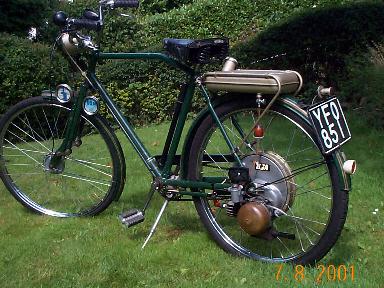That actually looks like quite a practical vehicle flecc - the motor position is much neater [and safer] down there.
What were they like to ride? speed? and I'm really curious about what sort of MOT you'd have to put them through now!
Thats the thing Red, laws were much more relaxed then and we had nothing like MOTs. However, motorcycle MOTs are nothing like as fearful as car ones can be, and the average independent motorcycle dealer would nod through one of these without much bother.
Among the cyclemotors I was most concerned with were the Cyclemasters which were in the back wheel like that BSA, but the whole motor and fuel tank were within a huge pressed steel hub so fully self contained. They were Dutch though originally designed by German DKW. The
25 cc original was black painted and gutless, the
later 32 cc painted grey and shown below the black one was a bit better though not as good as other motors.
The
BSA Winged Wheel above was a late entrant about 1952, more powerful but vibrated quite a lot and not as good as you might expect from 49 cc. That one above is adapted to a larger external fuel tank, there's the normal small tank in the hub.
The speed king was the
PowerPak, a 49 cc motor that sat above the rear wheel and drove the tyre by an alloy ribbed roller by friction and they could hit 30 mph plus downhill and flat out, though slightly slower on the flat. Once again the vibration could be severe at times and it wasn't uncommon for bike to be literally shaken to bits by it. It was also the shortest lived on the market, discontinued in 1955.
The French brought out the famous
VeloSolex with a 49 cc motor over the front wheel driving the tyre through a carborundum roller, and it was an entire bike designed from the ground up, step through, heavy and robust. The motor wasn't very powerful and it wasn't very fast, but it was much more refined than the add-ons though could still produce quite a throbbing vibration through the front of the bike.
There were several others like the noisy Mosquito and one produced by
Trojan under licence from an Italian design, but all the add ons disappeared in about a decade with the newly introduced Vespa and Lambretta scooters being far more attractive to a population getting richer in the late 1950s and 1960s. However, the VeloSolex amazingly continued in production until 1982.
In that brief decade of life these add-on cyclemotors were incredibly successful with registrations passing one million in the UK. Compare that with about 100,000 e-bikes at most after 17 years of them being marketed.
Nothing new under the sun though, so inevitably there was a forerunner to all these 1950s motors. Surprisingly early, the Wall Autowheel was made for bikes from 1912 until the mid 1920s. As you see
in this photo, it was a motorised wheel with it's own frame that sat alongside the bike's rear wheel.
.








